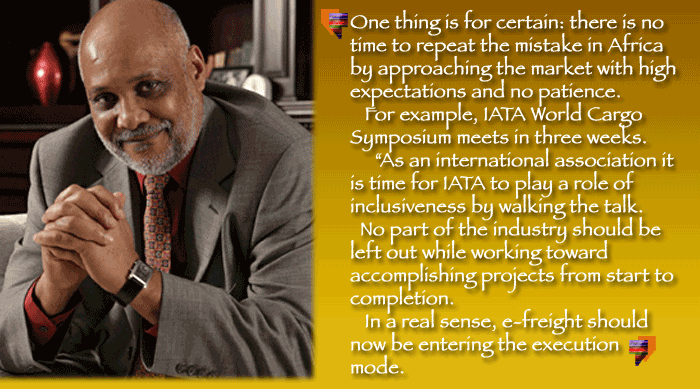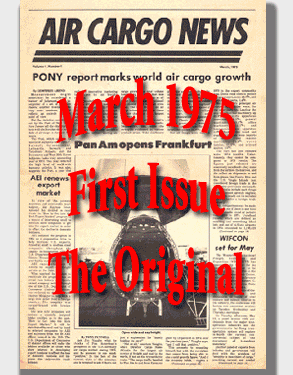|
 |

The first is Open Sky policy.
With just a few exceptions,
Africa still applies very strict landing rights that are
archaic in nature and designed to protect their small airlines.
These restrictions are one
of the major bottlenecks to growth as it suffocates imports
and exports of the local produce.
Just look, for example, to
Kenya that has developed into a leader in cut flowers because
of their Open Sky policy.
Elsewhere, Egypt is a top
exporter of green beans because of the right policies. Ghana
is on top because of pineapples and allowing airlines and
charter operators to fly in/out easily.”

The second item that needs
to be addressed if the Africa market is to move ahead is
the need to open up secondary airports to relieve the main
airports from pressure and to develop other regions of the
continent.
Just look at the numbers:
Of the 56 countries in Africa,
about 53 delivered positive GDP in 2012 and have done so
consistently during the past 3 years.
Consumer goods are anticipated
to reach a trillion dollars by 2020 for a growing African
middle class estimated at 350 million.

Worth mentioning as well
is that in almost every country there are ample supplies
of either gas, oil, or both as well as vast real estate
packed with minerals.
Africa indeed is the last
economic frontier.
The main stars moving ahead
in my opinion are Ghana, Botswana, Rwanda, and Tanzania.

Right now political stability
and the right policies are taking these countries into double-digit
growth.
And there are 33 other African
countries that now have multi-party political systems and
have held elections.
So things are changing.
The elections in Ghana in
December of 2012 were historic.
Very peaceful and the message
across the country was clear: ballots and not bullets.

Opening up the African market
top to bottom will require a massive influx of trained specialists
be brought to the fore.
The hope is that conferences,
such as Air Cargo Africa this week in Johannesburg, will
raise this issue.
Personally I would like to
see various international and also local African associations
cooperate in tackling the issue of training.
The internationals can help
in the trainers programs so that local associations can
move forward in devising apprenticeship programs.
Multi-nationals are moving
into Africa in a big way.
They should look at supporting
the local associations which exist in virtually every country.
One thing is for certain:
there is no time to repeat the mistake in Africa by approaching
the market with high expectations and no patience.
For example, IATA World Cargo
Symposium meets in three weeks.
As an international association
it is time for IATA to play a role of inclusiveness by walking
the talk.
 No
part of the industry should be left out while working toward
accomplishing projects from start to completion.
No
part of the industry should be left out while working toward
accomplishing projects from start to completion.
In a real sense, e-freight
should now be entering the execution mode.
Geoffrey
Editors Note: Issa Baluch may know as much about logistics
as anybody you ever met.
He has the chops and know-how
gained over a career that spans 37+ years, so when he puts
his thoughts down in black in white for the rest of us,
it’s our duty to study and ponder what he has to say.
The Baluch book, Transport
Logistics - Past, Present and Predictions, (available
on Amazon for $65.US ) is a 300-plus-page barnburner that
Prof. Issa created in 2005, and it still fascinates.
Who else sets the table for
modern logistics study with detailed examples of historic
projects that demanded careful transport logistics management?
Examples include what it took to build the Great Pyramid
in Egypt, and transport logistics practiced in the Berlin
Airlift and at the Battle of Stalingrad.
A second volume, The
Wheels of Commerce (Amazon $36.50) was created last
October (with Charles Edwards) and follows the thread in
an additional 340 pages.
Best known as the founder
of Dubai-based Swift Freight, a medium-sized multi-national
that was eventually sold to Barloworld, Issa has made several
lasting contributions to the world of logistics, including
his position as the guy who launched sea-air in Dubai.
These days in some kind of
“retirement”(as if he ever could be), Issa is
now teaching at Harvard and involved in projects at MIT,
where he is undoubtedly thinking big thoughts about logistics
whilst occasionally appearing at conferences to lend his
expertise and passion.
Issa is also involved in a
major farming initiative in Ghana, which is a whole “nother
story” as it is said, so stay tuned.
It is incredibly important
and invaluable for every stakeholder in air cargo to have
Issa’s take on Africa.
He is timely and ahead of
his time, and always, as his friend Ram Menen describes,
“a nice guy.”
We heartily second that notion.
 |
 |
Saudia
Cargo said it moved 516,000 tons in 2012, scoring a 21 percent
increase in revenue versus 2011. |
|
If
You Missed Any Of The Previous 3 Issues Of FlyingTypers
|
|||||
|
|||||
FT021213 |
FT021413Bulldog |
||||
|---|---|---|---|---|---|





 Good to see Johannesburg
as the venue for Air Cargo Africa this week, but from my
point of view a part of South Africa is still living under
sanctions of the past.
Good to see Johannesburg
as the venue for Air Cargo Africa this week, but from my
point of view a part of South Africa is still living under
sanctions of the past. 



 Of
course, the fate of freight rates also depends on the strength
of the global economic recovery. Initial signs in early
2013 suggest financial conditions are improving and policy
actions are providing stability.
Of
course, the fate of freight rates also depends on the strength
of the global economic recovery. Initial signs in early
2013 suggest financial conditions are improving and policy
actions are providing stability.
 When
he was 70 years old, the great playwright, author, singer,
and film director extraordinaire Noel “Cad”
Coward observed:
When
he was 70 years old, the great playwright, author, singer,
and film director extraordinaire Noel “Cad”
Coward observed:

